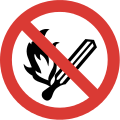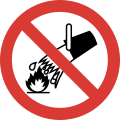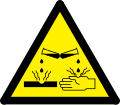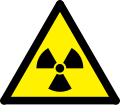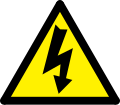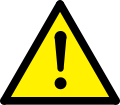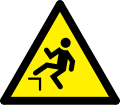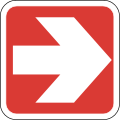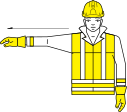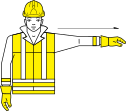Health and Safety (Safety Signs and Signals) Regulations 1996
| Statutory Instrument | |
 | |
| Citation | SI 1996/341 |
|---|---|
| Territorial extent | Great Britain |
| Dates | |
| Made | 18 February 1996 |
| Laid before Parliament | 23 February 1996 |
| Commencement | 1 April 1996 |
| Other legislation | |
| Repeals/revokes | Safety Signs Regulations 1980 |
| Transposes | Directive 92/58/EEC |
Status: Current legislation | |
| Text of statute as originally enacted | |
| Text of the Health and Safety (Safety Signs and Signals) Regulations 1996 as in force today (including any amendments) within the United Kingdom, from legislation.gov.uk. | |
It has been suggested that this article be merged into Directive 92/58/EEC. (Discuss) Proposed since April 2025. |
The Health and Safety (Safety Signs and Signals) Regulations 1996 specify the safety signs within Great Britain;[1] Northern Ireland has a similar law, the Health and Safety (Safety Signs and Signals) Regulations (Northern Ireland) 1996.[2] It was issued as a transposition of the European directive 92/58/EEC and replaced the Safety Signs Regulations 1980.[1] They consist of "traditional safety signs", such as prohibitory and warning signs, along with hand signals, spoken and acoustic signals, and hazard marking.[3]
Background
[edit]

Notable limitations to the previous legislation, The Safety Signs Regulations 1980, was that it excluded coal mining and tips; did not include signage related to fire fighting equipment, rescue/first aid equipment or emergency exits.[4] The law also simply stated signage required under the Health and Safety at Work etc. Act 1974 shall comply with BS 5378:Part 1: 1980, providing no further information on where signs should be posted, the incorporation of text or sizing of signage.[4] The standard also lacked this information as well as guidance on situations not effectively handled by a standard safety sign, such as blocking off hazardous areas, marking of traffic routes or use of acoustic or light signal for safety hazard.[5]
Application
[edit]The regulations apply to occupational health and safety within the territorial borders of Great Britain, also on offshore installations.[6][7][8] It does not apply to the marking of dangerous goods and substances itself, only its storage or pipes, nor the regulation of road, rail, inland waterway, sea or air traffic, nor to signs used aboard of sea-going ships.[1] For internal road traffic, traffic signs prescribed by the TSRGD, should be used.[6][9]
The Regulations do not require the usage of safety signs and signals for non-employees, such as customers, visitors or the general public.[6] However, section 3 of the Health and Safety at Work etc. Act 1974 requires employers to take reasonable efforts to protect the health and safety of non-employees from hazards posed by their work.[10] The Regulations note that signs provided may be used for this purpose.[11][6]
The Regulations require safety signage to be uniform and, as far as appropriate, without words, in order to be easily and fast understandable, without knowing the language.[11] Minor differences between the prescribed signs and the installed signs are allowed, as long as the convey the same message.[1][6] The Regulations also allow for designing a custom symbol when a suitable symbol does not exist in the regulation.[6] The symbol should follow BS ISO 3864-1:2011 and BS ISO 3864-4:2011 to ensure compliance with basic design principal.[6] The Health and Safety Executive specifically allows the usage of BS EN ISO 7010 safety signs.[6]
Safety signs should only be used, if other measures of avoiding hazards failed.[3][7] Also, if there is no risk, no safety signage should be used.[9] Employees should regularly be instructed about the meaning of safety signs and signals.[12][13] Employers are obligated to maintain the safety signage.[13]
Structure
[edit]The Health and Safety (Safety Signs and Signals) Regulations 1996 consists of 8 articles and 3 schedules.[1]
Schedule 1
[edit]Part I
[edit]As required in Annex I of the European directive 92/58/EEC, Schedule 1, Part I of the Regulations lays down a basic safety colour concept:[1][8]
| Colour | Meaning or purpose | Instructions and information |
|---|---|---|
| Red | Prohibition sign | Dangerous behaviour |
| Danger alarm | Stop, shutdown, emergency cut out devices, Evacuate | |
| Fire-fighting equipment | Identification and location | |
| Yellow or Amber | Warning sign | Be careful, take precautions |
| Examine | ||
| Blue | Mandatory sign | Specific behaviour or action |
| Wear personal protective equipment | ||
| Green | Emergency escape, first aid sign | Doors, exits, routes, equipment, facilities |
| No danger | Return to normal |
Part II
[edit]Schedule 1, Part II defines five types of signboards, as shown below.[1] They are also covered by BS 5378, Part 1 and 3 from 1980 and 1982,[7][14][15] which have been superseded by BS EN ISO 7010.[16][17][18] Safety signs must contain only symbols, not text.[7][13] However, supplementary text plates may be used.[13] For fire exits, the running man symbol should be used.[19] Fire safety signs in use before the Regulations were in place could be used until 24 December 1998.[12]
Prohibitory signs
[edit]-
No smoking
-
Smoking and naked flames forbidden
-
No access for pedestrians
-
Do not extinguish with water
-
Not drinkable
-
No access for unauthorised persons
-
No access for industrial vehicles
-
Do not touch
Warning signs
[edit]-
Flammable material or high temperature
-
Explosive material
-
Toxic material
-
Corrosive material
-
Radioactive material
-
Overhead load
-
Industrial vehicles
-
Danger: electricity
-
General danger
-
Laser beam (Version 1996)
-
Laser beam (Version 2009)
-
Oxidant material
-
Non-ionizing radiation
-
Strong magnetic field
-
Obstacles
-
Drop
-
Biological risk
-
Low temperature
Mandatory signs
[edit]-
Eye protection must be worn
-
Safety helmet must be worn
-
Ear protection must be worn
-
Respiratory equipment must be worn
-
Safety boots must be worn
-
Safety gloves must be worn
-
Safety overalls must be worn
-
Face protection must be worn
-
Safety harness must be worn
-
Pedestrians must use this route
-
General mandatory sign (to be accompanied where necessary by another sign)
Emergency escape or first-aid signs
[edit]-
Emergency exit/escape route
-
Emergency exit/escape route
-
Emergency exit/escape route
-
Emergency exit/escape route
-
Emergency exit/escape route
-
This way (supplementary information sign)
-
This way (supplementary information sign)
-
This way (supplementary information sign)
-
This way (supplementary information sign)
-
First-aid post
-
Stretcher
-
Safety shower
-
Eyewash
-
Emergency telephone for first-aid or escape
Fire-fighting signs
[edit]-
Fire hose
-
Ladder
-
Fire extinguisher (Version 1996)
-
Fire extinguisher (Version 2009)
-
Emergency fire telephone
-
This way (supplementary information sign)
-
This way (supplementary information sign)
-
This way (supplementary information sign)
-
This way (supplementary information sign)
Part III
[edit]This part, Minimum requirements governing signs on containers and pipes, defines the marking for the transport or storage of dangerous material by pipes and in containers, originally within the scope of the European directives 67/548/EEC and 1999/45/EC, which are both replaced by Regulation (EC) No 1272/2008, the CLP Regulation.[1] For marking, the warning signs of Part II should be used.[7]
Storage areas and rooms for dangerous substances are also required to be marked by suitable signage, either specifying the specific hazard, if all substances in the area have a common hazard, such as flammability, or using the 'general danger' symbol if different substances have various hazards. The regulation also explains differences and overlap with Dangerous Substances (Notification and Marking of Sites) Regulations 1990, which relates to requirements to mark facilities and sites where dangerous substances are stored in large quantities for firefighter safety.[1]
Part IV
[edit]The Minimum requirements for the identification and location of fire-fighting equipment specifies, that, additionally to the Fire-fighting signs of Part II, the equipment for fire-fighting and its location has to be marked red.[1]
Part V
[edit]In this part, the Minimum requirements governing signs used for obstacles and dangerous locations, and for marking traffic routes, requires hazardous places to be marked with either black and yellow or red and white markings. It also states that ways used for traffic have to be marked with either white or yellow stripes.[1]
The Health and Safety Executive expects employers to establish and mark traffic routes when necessary to ensure workplace safety, such as where powered industrial trucks are in use, especially in proximity to workers on foot. Employers are also expected to take steps to ensure safe flow of traffic, such as providing a banksman to guide reversing vehicles near people on foot or near hazardous conditions such as a drop off.[1]
Part VI
[edit]Part VI, Minimum requirements for illuminated signs, requires illuminated signs to be single-coloured or to contain a symbol. If the latter is the case, it should comply with Part II. If a flashing light and a sound are used together, they have to be synchronized.[1]
Part VII
[edit]This part, the Minimum requirements for acoustic signals, requires acoustic signals to be understandable and not harmful. If the acoustic signal is an fire alarm, it has to be continuing.[1]
Part VIII
[edit]The Minimum requirements for verbal communication defines the use of language for safety purposes. It also defines coded words:[1]
| Meaning | |
|---|---|
| start | to indicate the start of a command |
| stop | to interrupt or end a movement |
| end | to stop the operation |
| raise | to have a load raised |
| lower | to have a load lowered |
| forwards | to be co-ordinated with the corresponding hand signals |
| backwards | |
| right | |
| left | |
| danger | for an emergency stop |
| quickly | to speed up a movement for safety reasons |
Part IX
[edit]Hand signals should only be given by one instructor.[8] Other hand signals are also allowed, as specified in Schedule 2.[1]
Updates since 1996
[edit]
Since it's introduction in 1996, the Regulations have undergone some changes. The 'Harmful or irritant material' warning sign was completely removed from the Regulations on 6 January, 2015.[20] This was in response to CLP Regulations amending Directive 92/58/EEC to remove the sign as part of harmonization with Globally Harmonized System of Classification and Labelling of Chemicals , which discontinued use of an "X" to identify harmful and irritating substances.[21]
In 2015, the third edition of Safety Signs and Signals, by the Health and Safety Executive was released. The guidance reinforced existing guidance that "small differences from the pictograms or symbols shown in Schedule 1 of the Regulations are acceptable" by directly referencing that EN ISO 7010 symbols were considered to be acceptable for use instead of the designs provided in the Regulations, as they conformed to the 'intrinsic features' specified in the law.[6]
Legacy
[edit]Health and Safety (Safety Signs and Signals) Regulations 1996 brought about a significant move to uniformity in the appearance safety sign design in the United Kingdom. British Rail's successor Railtrack started to phase out usage of the railway's 'red warning flash' signage, in use for over 35 years, in August 1997.[22][23] The railway's signs for warning staff of areas of limited clearance, marked by simple chequered board design dating back to the 1952, was also to be phased out in favor of a standard warning design. However, the chequered design has persisted, still part of the standard for relevant safety sign standard as of 2025, nearly 30 years after the 1996 legislation's enactment, owing to staff familiarity with the pervious non-standard design.[24]
See also
[edit]- Traffic Signs Regulations and General Directions, a similar statutory instrument for traffic signs
- Globally Harmonized System of Classification and Labelling of Chemicals
References
[edit]![]() This article incorporates text published under the British Open Government Licence v3.0:
This article incorporates text published under the British Open Government Licence v3.0:
- ^ a b c d e f g h i j k l m n o p "The Health and Safety (Safety Signs and Signals) Regulations 1996". legislation.gov.uk. Retrieved 1 September 2023.
- ^ "Health and Safety (Safety Signs and Signals) Regulations (Northern Ireland) 1996". legislation.gov.uk. Retrieved 1 September 2023.
- ^ a b "Safety Signs L6" (PDF). Northumberland County Council. February 2014. Retrieved 18 September 2023.
- ^ a b "SI No. 1471 - The Safety Signs Regulations 1980" (PDF). legislation.gov.uk. London: Government of the United Kingdom. 3 October 1980. Retrieved 6 May 2025.
- ^ BS 5378:1 Safety Signs and Colours - Part 1: Specification for Colour and Design. British Standard. 1980 [1980].
- ^ a b c d e f g h i Safety signs and signals. The Health and Safety Regulations 1996. Guidance on Regulations (3rd ed.). Health and Safety Executive. 2015. ISBN 9780717665983.
- ^ a b c d e Stranks, Jeremy W. (2005). Health and Safety Law (5th ed.). Harlow: Pearson Education. p. 221. ISBN 9780131976467.
- ^ a b c Ridley, John (2013). Health and Safety In Brief (2nd ed.). Routledge. pp. 82–85. ISBN 9781136399619.
- ^ a b "Safety Signage". Queen Mary University of London. Retrieved 18 September 2023.
- ^ "Health and Safety at Work etc. Act 1974 - Section 3 - General duties of employers and self-employed to persons other than their employees". legislation.gov.uk. Government of the United Kingdom. 1974. Retrieved 13 May 2025.
- ^ a b St John Holt, Allan; Allen, Jim (2015). Principles of Health and Safety at Work (8th ed.). Routledge. ISBN 9781317341260.
- ^ a b Rowland, Edward; Day, Bob (2007). Health, Safety and Environment Legislation: A Pocket Guide. Royal Society of Chemistry. pp. 125–126. ISBN 9781847551047.
- ^ a b c d Hughes, Phil; Ferrett, Ed (2020). Introduction to Health and Safety at Work: for the NEBOSH National General Certificate in Occupational Health and Safety (7th ed.). Routledge. pp. 505–507. ISBN 9781000214215.
- ^ BS 5378-1:1980 Safety signs and colours - Specification for colour and design. London: British Standards Institution. 1980.
- ^ BS 5378-3:1982 Safety signs and colours - Specification for additional signs to those given in BS 5378:Part 1. London: British Standards Institution. 1982.
- ^ BS EN ISO 7010:2020+A6:2023 Graphical symbols. Safety colours and safety signs. Registered safety signs. London: British Standards Institution. 2023.
- ^ "BS 5378-1:1980 Safety signs and colours - Specification for colour and design". British Standards Institution. 22 September 2023. Retrieved 22 September 2023.
- ^ "BS 5378-3:1982 Safety signs and colours - Specification for additional signs to those given in BS 5378:Part 1". British Standards Institution. 22 September 2023. Retrieved 22 September 2023.
- ^ Hunt, Garry (2018). Health and Safety Pocket Book (2nd ed.). Abingdon, Oxon: Routledge. p. 112. ISBN 9781138091450.
- ^ a b "The Health and Safety (Safety Signs and Signals) Regulations 1996 - 2015 amendments" (PDF). legislation.gov.uk. 1 January 2015. Retrieved 7 May 2025.
- ^ "Directive 2014/27/EU of the European Parliament and of the Council of 26 February 2014 amending Council Directives 92/58/EEC, 92/85/EEC, 94/33/EC, 98/24/EC and Directive 2004/37/EC of the European Parliament and of the Council, in order to align them to Regulation (EC) No 1272/2008 on classification, labelling and packaging of substances and mixtures". Official Journal of the European Union. 57: 1–7. 5 March 2014. Retrieved 22 August 2023.
(a) warning sign 'Harmful or irritant material' is deleted.
- ^ Your Personal Safety - Operating Staff. British Railways. 1960s. p. 18.
- ^ "GM/RT1041 - Warning Signs and Notices for Electrified Lines". rssb.co.uk. Rail Safety & Standards Board. August 1997. Retrieved 6 May 2025.
- ^ "Sign BA04: Limited Clearance Sign". rssb.co.uk. Rail Safety & Standards Board. Retrieved 6 May 2025.
External links
[edit] Media related to The Health and Safety (Safety Signs and Signals) Regulations 1996 (UK) at Wikimedia Commons
Media related to The Health and Safety (Safety Signs and Signals) Regulations 1996 (UK) at Wikimedia Commons The full text of The Health and Safety (Safety Signs and Signals) Regulations 1996 at Wikisource
The full text of The Health and Safety (Safety Signs and Signals) Regulations 1996 at Wikisource


